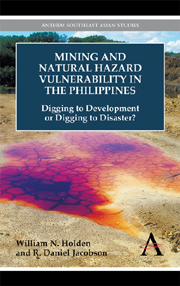 Mining and Natural Hazard Vulnerability in the Philippines
Mining and Natural Hazard Vulnerability in the Philippines Book contents
- Frontmatter
- Contents
- Acknowledgments
- List of Tables and Figures
- List of Acronyms
- Introduction
- Chapter One Mining in the Philippines
- Chapter Two Government Efforts to Encourage Mining
- Chapter Three Environmental Effects of Mining
- Chapter Four Mining amid Natural Hazards
- Chapter Five Technocratic Responses to the Risks
- Chapter Six Risk Society in the Philippines
- Chapter Seven Mining as a Flawed Development Paradigm
- Chapter Eight Is Another World Possible?
- Conclusion
- Bibliography
- Index
Chapter Seven - Mining as a Flawed Development Paradigm
Published online by Cambridge University Press: 05 May 2012
- Frontmatter
- Contents
- Acknowledgments
- List of Tables and Figures
- List of Acronyms
- Introduction
- Chapter One Mining in the Philippines
- Chapter Two Government Efforts to Encourage Mining
- Chapter Three Environmental Effects of Mining
- Chapter Four Mining amid Natural Hazards
- Chapter Five Technocratic Responses to the Risks
- Chapter Six Risk Society in the Philippines
- Chapter Seven Mining as a Flawed Development Paradigm
- Chapter Eight Is Another World Possible?
- Conclusion
- Bibliography
- Index
Summary
Mining: A Questionable Development Strategy
Given the risks associated with locating large-scale mining projects amid the natural hazards present in the Philippines, and the reluctance of many members of that archipelago's civil society to accept technological solutions to these risks, one may wonder whether a mining-based development paradigm is an appropriate approach to be followed. Will mining-related environmental disruptions brought on by the interactions of mining's environmental effects and the natural hazards present in the Philippines only serve to disrupt the ecology of the poor and end up impoverishing vulnerable communities adjacent to mining operations? Alternatively, will mining act as an engine of economic growth and generate so much prosperity that whatever instances of environmental disruption may occur can easily be compensated for by the subsequent rising tide of prosperity that “lifts all boats?”
The Twin Pillars of Sustainable Development
In addressing the efficacy of any development strategy, the concept of sustainable development is a useful metric. In 1987, the World Commission on Environment and Development defined the now ubiquitous term “sustainable development” as being “development that meets the needs of the present without compromising the ability of future generations to meet their own needs” (World Commission on Environment and Development 1987, 43). However, this definition may only be viewed as a starting point in discussions of sustainable development because much of this discussion directs its attention not on the negative consequences of economic growth upon the environment, but on the negative consequences of environmental degradation upon economic growth (Holden 2009b).
- Type
- Chapter
- Information
- Mining and Natural Hazard Vulnerability in the PhilippinesDigging to Development or Digging to Disaster?, pp. 185 - 224Publisher: Anthem PressPrint publication year: 2012


